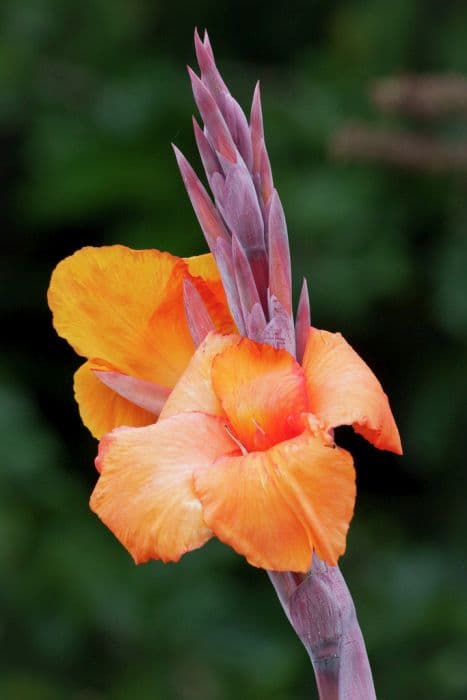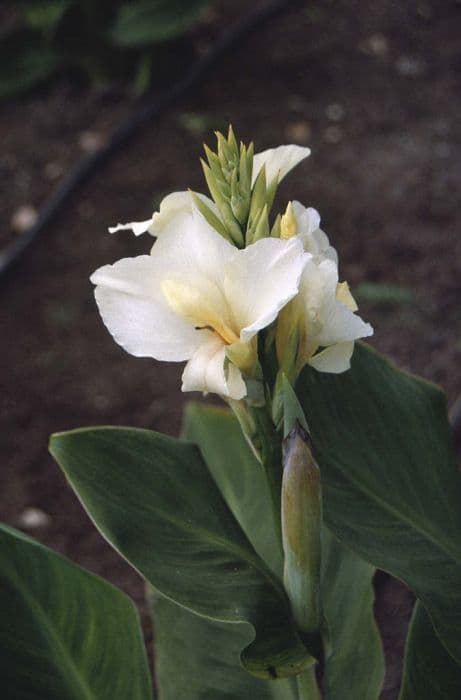Tropicanna Canna Canna 'Phasion' (v)

ABOUT
Canna 'Phasion', also known as Tropicanna Canna, exhibits a striking display with its vibrant foliage and stunning flowers. The foliage is one of its most remarkable features, characterized by broad, banana-like leaves that boast a range of colors, including deep purples, bright greens, and rich oranges, all streaked and striped in a tapestry of color that adds dramatic interest to any garden space. The leaves seem to capture the essence of a tropical sunset and make the Tropicanna Canna a real standout among garden plants. The spellbinding colors of the leaves provide a perfect backdrop for the Tropicanna Canna's flowers, which rise above the foliage on tall stems. These blossoms are equally impressive, typically presenting in bold shades of red or fiery orange. The flowers have a flared, funnel shape and are known to be large and showy, making them a focal point of the plant. They add a touch of exotic glamour to the plant's appearance and are attractive to pollinators such as hummingbirds and bees. The overall impression of the Tropicanna Canna is one of a lush, tropical paradise. Its appearance is a blend of warm colors that imbue the garden with an atmosphere of a perpetual, vibrant summer, regardless of the setting. The Tropicanna Canna's flamboyant appearance makes it a popular choice for gardeners looking to inject a burst of color and excitement into their landscapes.
About this plant
 Names
NamesFamily
Cannaceae.
Synonyms
Tropicanna Canna, Variegated Canna, Orange Punch Canna.
Common names
Canna 'Tropicanna'
 Characteristics
CharacteristicsLife cycle
Perennials
Foliage type
Deciduous
Color of leaves
Mixed
Flower color
Orange
Height
4-6 feet (1.2-1.8 meters)
Spread
1-2 feet (0.3-0.6 meters)
Plant type
Bulb
Hardiness zones
7-10
Native area
South America
Benefits
 General Benefits
General Benefits- Vibrant Colors: The Canna 'Phasion', also known as Tropicanna Canna, offers striking foliage that is variegated with shades of green, yellow, pink, and red, making it a standout addition to any garden.
- Ornamental Flowers: It blooms with beautiful, large flowers that can range in color from orange to deep red, adding an exotic and tropical flair to landscapes.
- Easy to Grow: Tropicanna Canna is relatively easy to care for and can thrive in a variety of soil types, as long as they are well-draining.
- Fast Growth: It has a rapid growth rate, which allows gardeners to enjoy its full splendor relatively quickly after planting.
- Height and Structure: It grows tall, up to 4-6 feet, which can provide vertical interest and structure to garden beds or as a backdrop for other lower-growing plants.
- Attracts Wildlife: The vibrant blooms of the Tropicanna Canna attract pollinators such as butterflies and hummingbirds, promoting biodiversity.
- Drought Tolerance: Once established, it demonstrates good drought tolerance, making it suitable for warmer climates and reducing the need for frequent watering.
- Versatile Planting Options: It can be planted in the ground or in containers, providing flexibility for gardeners with limited space or those who wish to add tropical accents to patios or balconies.
 Medical Properties
Medical PropertiesThis plant is not used for medical purposes.
 Air-purifying Qualities
Air-purifying QualitiesThis plant is not specifically known for air purifying qualities.
 Other Uses
Other Uses- Craft Material: The large, colorful leaves of the Canna 'Phasion' can be used in various crafts, such as making natural leaf prints or pressing them for artistic projects.
- Dye Source: The bright pigments of the leaves and flowers may be used to create natural dyes for textiles or art supplies.
- Fish Pond Accent: When planted near fish ponds, Canna 'Phasion' adds aesthetic value and can provide shade for aquatic life.
- Educational Resource: The distinct foliage and rapid growth make it an ideal plant for educational purposes, teaching students about plant biology and cultivation.
- Photography Subject: Its vibrant colors and unique appearance make it a popular subject for photographers, particularly in garden and nature photography.
- Habitat Enrichment: By planting Canna 'Phasion' in gardens, one can provide shelter and food for a variety of insects and small wildlife.
- Soil Erosion Control: This plant can also be used for stabilizing soil on banks and slopes, due to its dense growth and large root system.
- Gastronomy: Although not widely known, the rhizomes of the Canna 'Phasion' are edible and can be used in some culinary traditions after proper processing.
- Religious and Cultural Symbolism: In some cultures, Canna 'Phasion' may have religious or ceremonial uses because of its striking appearance.
- Biodegradable Container Gardens: The sturdy leaves can be fashioned into biodegradable container gardens for starting other plants or growing small, shallow-root plants.
Interesting Facts
 Feng Shui
Feng ShuiThe Tropicanna Canna is not used in Feng Shui practice.
 Zodiac Sign Compitability
Zodiac Sign CompitabilityThe Tropicanna Canna is not used in astrology practice.
 Plant Symbolism
Plant Symbolism- Change and Transition: The vibrant, multi-colored leaves of the Canna 'Phasion', also known as Tropicanna Canna, symbolize the flux and progression of life. The foliage undergoes various changes in hue, representing adaptability and transformation.
- Creativity and Inspiration: Tropicanna Canna's striking appearance and bright colors are thought to evoke creativity and inspire artists, gardeners, and anyone seeking a muse.
- Confidence and Pride: With its bold presence and stature, the Tropicanna Canna embodies confidence and pride. It is often associated with individuals who hold themselves with self-assuredness and dignity.
- Vibrancy and Enthusiasm: The intense colors and lush growth of Tropicanna Canna suggest exuberance and zest for life, making it a symbol of positive energy and enthusiasm.
 Water
WaterThe Tropicanna Canna requires consistent moisture and should be watered thoroughly when the top inch of soil feels dry to the touch. During hot weather, this can mean watering every other day, ensuring the plant receives about 2 gallons of water each week. Allow the water to soak deep into the soil to encourage root growth. In cooler weather or during periods of rain, water less frequently, being careful not to overwater and waterlog the plant. It's essential to provide enough water to keep the soil moist but not soggy.
 Light
LightThe Tropicanna Canna thrives in full sun and requires at least six hours of direct sunlight each day for optimal growth and blooming. The ideal spot for this plant is in an open area where sunlight is plentiful throughout the day. However, in extremely hot climates, a little afternoon shade can help protect the plant from intense heat.
 Temperature
TemperatureThe Tropicanna Canna prefers warm temperatures and grows best when daytime temperatures are between 70°F and 90°F. It can survive minimum temperatures down to about 50°F; however, temperatures below this can cause the plant to go dormant. The ideal temperature range for this canna lily to flourish is between 70°F and 85°F.
 Pruning
PruningPruning the Tropicanna Canna is essential for maintaining its appearance and encouraging more blooms. Cut back any spent flowers and remove yellowing leaves to stimulate new growth. Prune the canna lilies back to the ground in late fall or early winter after the foliage has died back. Typically, Tropicanna Canna should be pruned once per season, ideally during its dormant period.
 Cleaning
CleaningAs needed
 Soil
SoilTropicanna Canna requires well-draining, rich soil with a pH between 6.0 and 6.5. A good soil mix for this canna would include compost, peat moss, and perlite or vermiculite to ensure proper drainage and fertility.
 Repotting
RepottingTropicanna Canna should typically be repotted every 2 to 3 years to refresh the soil and accommodate its growth. It’s best to repot in spring just before the growing season begins.
 Humidity & Misting
Humidity & MistingTropicanna Canna thrives in average to high humidity conditions. It is best to aim for a humidity level around 50% to 70% for optimal growth.
 Suitable locations
Suitable locationsIndoor
Ensure bright light, warm temps, and room for growth.
Outdoor
Full sun to partial shade, moist soil, protect in frost.
Hardiness zone
7-11 USDA
 Life cycle
Life cycleThe life cycle of the Canna 'Phasion', commonly known as Tropicanna Canna, begins with the germination of rhizomes, where the dormant buds swell and develop into shoots. These shoots grow rapidly into stems with large, colorful, variegated leaves that can reach a few feet in height. Alongside leaf growth, flowering stalks emerge from the stems, producing vibrant, showy flowers that bloom throughout the summer. After pollination, the flowers may produce seeds, but Tropicanna Cannas are often propagated vegetatively via rhizome division. As autumn approaches, the plant begins to enter dormancy; foliage dies back with the onset of colder temperatures. The rhizomes overwinter in the ground or are stored in cool, dry conditions to be replanted in the spring, marking the beginning of a new growth cycle.
 Propogation
PropogationPropogation time
Spring to Summer
Propogation: Canna 'Phasion', also commonly known as Tropicanna Canna, is best propagated by dividing its rhizomes. The ideal time to propagate Tropicanna Canna is in the spring when the plant emerges from dormancy and begins to show new growth. To propagate, carefully dig up the clump of rhizomes and using a sharp knife, divide the rhizomes, ensuring that each division has at least one eye or growth point. The divisions can then be planted in a well-draining soil mix at a depth of about 4 inches (approximately 10 centimeters), spacing them 1 to 2 feet (30 to 61 centimeters) apart to allow for growth. Water the newly planted rhizomes thoroughly to establish them. This method of vegetative propagation ensures that the striking variegated foliage and vibrant blooms characteristic of the 'Phasion' variety are reliably reproduced in the new plants.









![Canna [Tropicanna Black]](/_next/image?url=https%3A%2F%2Fplants-admin.emdemapps.com%2Fimages%2Fplants%2F%2Fimages%2F604b5ba79b97e.png&w=640&q=75)